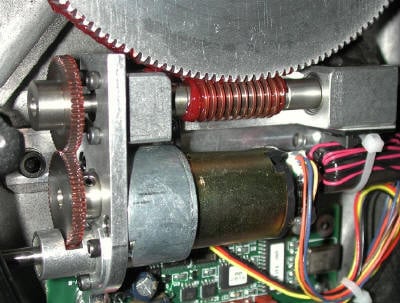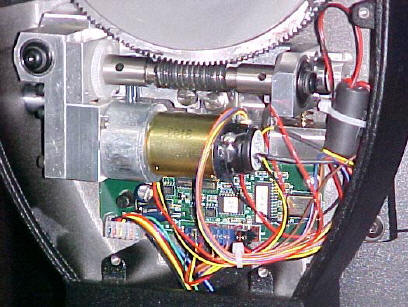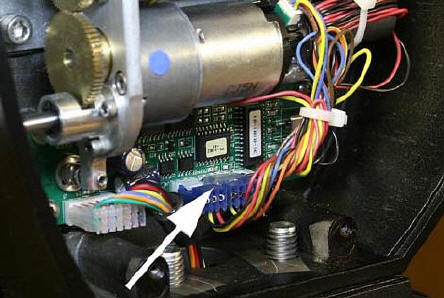
405 New Meadow Rd
Barrington RI 02806 USA
Questions? Contact us at:
1-401-245-4068
info@petersonengineering.com
Buck's Gears or Buck's Tune-Up?
Which upgrade do you need?
Meade incorporated a new and much improved drive with the introduction of the LX200 GPS telescope, and an even more sophisticated drive in the 14″ version of the LX200 GPS. These two basic drive designs are still used in all later Meade telescopes.
Drives in earlier Meade LX200GPS and RCX400 scopes had weak low cost plastic gears. Meade eventually converted to precision brass gears. During the Summer 2005 to Spring 2006 conversion period Meade shipped scopes with mixed gear types and drive types.
The Buck’s Gears kit replaces loose tolerance molded plastic transfer gears originally used in these telescopes with high precision machined stainless steel gears while making numerous adjustments, alignments and corrections. Since 50% of the performance improvement achieved with the Buck’s Gears kit was associated with the adjustments, the Buck’s Tune-Up was introduced so that all subsequent Meade scopes using precision brass gears could also achieve maximum mechanical precision.
So which upgrade do you need? It depends upon which version of the drive your telescope contains, and whether that drive is equipped with plastic or precision metal gears. Meade mixed plastic with metal for a period as long as 9 or 10 months before and after September 2005, and they occasionally have substituted the standard drives from the 8″, 10″ and 12″ scopes in place of what we refer to as the “Big Scope” drives originally designed for use in the 14″ scopes. The following match-up is pretty reliable but if you (or we) have a question it’s best to check the pictures below and then open your scope and check for yourself.
Buck’s Gears – For “standard” drives with plastic transfer gears With the exception of the RCX 400, all Meade 7″, 8″, 10″ and 12″ scopes use “standard” drives. GPS scopes manufactured before September 2005 contain plastic transfer gears. 8″ through 12″ GPS scopes manufactured between September 2005 and June 2006 and the early production LX200R scopes may contain plastic transfer gears. (The LX200GPS, LX200R, LX200ACF and LX600 are all essentially the same scope with different nomenclature but the same drives. The LX200GPS was produced from 2001 to 2007. Subsequent LX200 models were made with an improved corrector plate. The first of these, the LX200R was produced in 2008 & 2009 or so, but when a court struck down Meade’s claim to it being a true RitchieCrichton optical system Meade then changed the name to the currently used LX200ACF. The LX600 utilizes slightly modified optics to achieve a shorter focal length, but drive design remains unchanged.)
Buck’s Big Scope Gears – For “Big Scope” drives with plastic transfer gears Almost all 14″ Meade scopes use what we term the “Big Scope” drive, but during the conversion from plastic to precision brass gears Meade experimented with using “Standard” drives in the declination. Meade also utilized the Big Scope version of the drive in all RCX400 scopes. All 14″ scopes manufactured before February 2005 are certain to have plastic transfer gears. Those 14″ and RCX scopes manufactured between Feb 2005 and June 2006 may have plastic transfer gears, metal transfer gears, or a combination. All Big Scope drives in scopes shipped after June 2006 have precision metal gears.
How to inspect your drive:
Turn off your telescope. Unscrew the declination locking knob, turning it counterclockwise. Remove the knob assembly (includes knob, escutcheon plate and 2 spacers – one on each side of the escutcheon plate). Put a finger or two through the hole in the now exposed plastic drive cover, and push against the steel plate inside. This is the outer clutch plate. It’s riding on 2 short pins and we don’t want it to fall off and onto the declination drive motor below. Now, using a 3/32″ hex wrench, remove the 6 or 7 socket head cap screws holding the plastic drive cover in place. Note that the 2 bottom screws may be a bit longer than the others. Inspect your drive. When replacing the cover be careful not to pinch any stray wires between the cover and the fork arm.
Here’s what the “standard’ drive looks like.
The transfer gears are the gears at the left side of the picture. This particular picture shows the standard drive after Buck’s precision stainless steel Gears have been installed.


Here’s what the “Big Scope” drive looks like:
There’s a white plastic transfer gear is on the left side of the wormshaft, and it’s meshing with a gear underneath it that’s poking out from the inside of the motor section.
This scope has Meade’s precision brass transfer gears. But here’s an additional thing to look for if you open your scope:
Meade occasionally assembles experimental parts into production telescopes and Meade occasionally changes their design and their assembly procedures. This is a picture of the standard drive in an LX200 ACF scope manufactured in June 2009. Meade used hot melt glue to permanently bond wire connectors from the declination drive to the circuit board. Examine your declination drive connectors. If your connectors are hot glued you cannot use Buck’s Gears or Buck’s Tune-Up. Attempting to remove the hot melt will probably irreparably damage your circuit board.

Note that these upgrade kits do not fit the LX90 or the LX200 Classic scopes